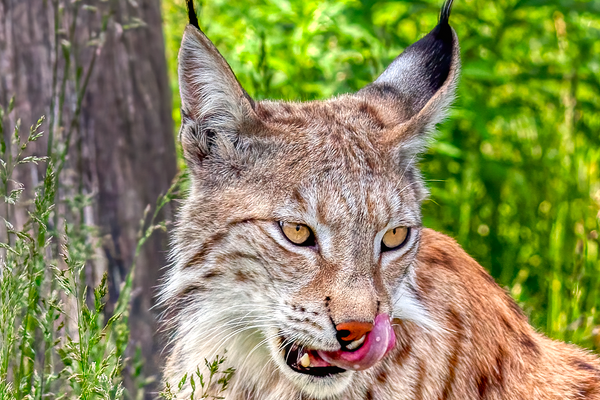Hemingway’s Six-Toed Cats, Whose Future Remains Fuzzy
Ernest Hemingway’s kitten Cristobal, date unknown (photograph via the John F. Kennedy Library and Museum)
Tucked away in the heart of Old Town Key West sits the Hemingway Home and Museum, an homage to the man who wrote what are widely considered his greatest novels during his ten years living in the Florida Keys. Tourists and literary buffs alike flock to the Spanish Colonial to view the remnants of Papa Hemingway’s estate, from his old typewriter to his beloved bar urinal turned water fountain, and the 40 to 50 polydactyl cats who currently roam the property and call the museum home.
A mitten-pawed polydactyl cat lounges on the property of the Hemingway Home and Museum (photograph via Wikimedia Commons)
While the common cat has 18 toes total, five on each front paw and four on the back, the polydactyl cat carries a genetic abnormality which allows them to have anywhere from four to seven toes per paw. Only about half of the cats at Hemingway Home have additional toes, but they all seem to be carriers of the polydactyl gene and are therefore able to pass on the physical trait to their offspring. The estate’s felines are all thought to be descendants of Hemingway’s original six-toed cat Snowball, a ship cat that the author received as a present from a captain and greatly adored.

Hemingway’s family of cat lovers, Cuba circa 1943 (via the John F. Kennedy Presidential Library and Museum)
A ship cat shows off his climbing prowess (via the National Maritime Museum)
Six-toed cats have something of a nautical history; sailors considered the cats lucky and often brought polydactyls along for long sea voyages. The cats are also said to be extremely skilled hunters and climbers, making them an excellent crew addition when it came to keeping a ship free of rats. Whether or not the polydactyl gene originated in New England or the UK is unknown, but there does seem to be evidence that the city of Boston, Massachusetts is fairly intricately involved with the spread of the trait.
Six-toed cat populations seem to have sprung up in several pockets along the east coast of the United States in direct correlation with the dates that various ports first established a shipping trade with Boston. Smaller breeds of extra-digited felines still exist up and down the east coast, including the Boston thumb cat, the Vermont Snowshoe cat, and the New York Ithacat. The added toes were also historically quite common on Maine Coons and are thought to have aided with walking through heavy snow and catching fish. The gene is quite a bit rarer in Europe, but this may be because six-toed cats were historically associated with sorcery and the devil and were often killed, accused of being familiars of witches. Their North American relatives faired significantly better, making it all the way to the White House where avid animal lover Teddy Roosevelt was said to have pampered his polydactyl pet cat Slippers during his presidency.
Archie the cat lounges on the antique bed in the Hemingway House (photograph by Sofia K.)
A Hemingway Home feline surveys his territory (photograph by Abujoy/Wikimedia)
Killjoy sign at the Hemingway Home (photograph by Patrick Haney)
As for the descendants of Hemingway’s beloved Snowball, the extra-toed kitties have inherited free rein of the author’s former estate. They can be found prowling the grounds, lounging inside on antique furniture, and soaking up the love and attention of crowds of daily visitors. Along with being fed and cared for, the cats receive regular veterinary visits and by all appearances seem to be living the good life, but their celebrated lifestyle may be coming to an end.
In recent years the Hemingway Home and Museum has fallen into a long, drawn-out legal battle with the U.S. Department of Agriculture, currently insisting that the museum needs an exhibitor’s license to keep the cats in accordance with the federal regulations of the Animal Welfare Act. The same license that is required of zoos and circuses, the exhibitor’s license would mean several significant changes for the Hemingway polydactyls. The cats would have to be placed in cages at night, a higher fence or an electrically wired enclosure would need to go up around the property, and the museum would be required to hire a night guard to ensure the cats were properly contained. There has been quite a lot of back and forth between government agencies, the courts, and the museum over the past several years, but for now the future of Hemingway’s furry, six-toed felines remains, unfortunately, fuzzy.
Cat sleeping at the Hemingway Home (photograph by actor212/Flickr user)
Asleep in Key West (photograph by James Willamor)
Cat on a museum display (photograph by actor212/Flickr user)
A particularly pretty polydactyl at the Hemingway Home (photograph by Abujoy/Wikimedia)
Cat showing off its many toes (photograph by failing_angel/Flickr user)
ERNEST HEMINGWAY HOME & MUSEUM, Key West, Florida
Animal Week is November 18 - 22, 2013 on Atlas Obscura.
Join us on Facebook, Twitter (#AnimalWeek), and Tumblr for even more animal action and to share your own tales of fascinating fauna.
















Follow us on Twitter to get the latest on the world's hidden wonders.
Like us on Facebook to get the latest on the world's hidden wonders.
Follow us on Twitter Like us on Facebook